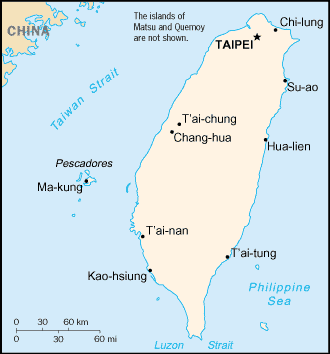Country name:
conventional long form: none conventional short form:Taiwan local long form:none local short form:Taiwan former:Formosa

Government type:
multiparty democracy

Capital:
name:Taipeigeographic coordinates:25 02 N, 121 31 E time difference:UTC+8 (13 hours ahead of Washington, DC, during Standard Time)

Administrative divisions:
includes main island of Taiwan plus smaller islands nearby and off coast of China's Fujian Province; Taiwan is divided into 14 counties (hsien, singular and plural), 3 municipalities (shih, singular and plural), and 5 special municipalities (chih-hsia-shih, singular and plural)

National holiday:
Republic Day (Anniversary of the Chinese Revolution), 10 October (1911)

Constitution:
previous 1912, 1931; latest adopted 25 December 1946, promulgated 1 January 1947, effective 25 December 1947; revised several times, last in 2005 (2013)

Legal system:
civil law system

International law organization participation:
has not submitted an ICJ jurisdiction declaration; non-party state to the ICCt

Suffrage:
20 years of age; universal

Executive branch:
chief of state:President MA Ying-jeou (since 20 May 2008); Vice President WU Den-yih (since 20 May 2012)head of government:Premier JIANG Yi-huah (President of the Executive Yuan) (since 18 February 2013); Vice Premier MAO Chi-kuo (Vice President of the Executive Yuan) (since 18 February 2013) cabinet:Executive Yuan - ministers appointed by president on recommendation of premier elections:president and vice president elected on the same ticket by popular vote for four-year terms (eligible for a second term); election last held on 14 January 2012 (next to be held in January 2016); premier appointed by the president; vice premiers appointed by the president on the recommendation of the premier election results:MA Ying-jeou elected president; percent of vote - MA Ying-jeou 51.6%, TSAI Ing-wen 45.6%, James SOONG Chu-ye 2.8%

Legislative branch:
unicameral Legislative Yuan (113 seats - 73 district members elected by popular vote, 34 at-large members elected on basis of proportion of islandwide votes received by participating political parties, 6 elected by popular vote among aboriginal populations; members to serve four-year terms); parties must receive 5% of vote to qualify for at-large seatselections:Legislative Yuan - last held on 14 January 2012 (next to be held in January 2016) election results:Legislative Yuan - percent of vote by party - KMT 44.6%, DPP 34.6%, TSU 9.0%, PFP 5.5%, others 6.3%; seats by party - KMT 64, DPP 40, PFP 3, TSU 3, NPSU 2, independent 1

Judicial branch:
highest court(s):Supreme Court (consists of the court president, vice president, and approximately 100 judges organized into 8 civil and 12 criminal divisions, each with a division chief justice and 4 associate justices); Constitutional Court (consists of the court president, vice president, and 13 justices)judge selection and term of office:both Supreme Court and Constitutional Court justices appointed by the president of the republic with the approval of the Legislative Yuan; Supreme Court justices appointed for life; Constitutional Court president, vice-president, and 8 grand justices serve 4-year terms and remaining justices serve 8-year terms subordinate courts:high courts; district courts; hierarchy of administrative courts

| | Political parties and leaders:
Democratic Progressive Party or DPP [SU Tseng-chang]Kuomintang or KMT (Nationalist Party) [MA Ying-jeou] New Party [YOK Mu-ming] Non-Partisan Solidarity Union or NPSU [LIN Pin-kuan] People First Party or PFP [James SOONG Chu-ye] Taiwan Solidarity Union or TSU [HUANG Kun-huei]

Political pressure groups and leaders:
environmental groups

International organization participation:
ADB, APEC, BCIE, ICC (national committees), IOC, ITUC (NGOs), WTO

Diplomatic representation in the US:
representative:SHEN Lyu-shin (since 1 April 2014) office:4201 Wisconsin Avenue NW, Washington, DC 20016 telephone:[1] 202 895-1800 Taipei Economic and Cultural Offices (branch offices):Atlanta, Boston, Chicago, Guam, Houston, Honolulu, Kansas City, Los Angeles, Miami, New York, San Francisco, Seattle

Diplomatic representation from the US:
director:Christopher J. MARUT office:#7 Lane 134, Hsin Yi Road, Section 3, Taipei 106, Taiwan telephone:[1] [886] (02) 2162-2000 FAX:[1] [886] (02) 2162-2251 other offices:Kaohsiung

Flag description:
red field with a dark blue rectangle in the upper hoist-side corner bearing a white sun with 12 triangular rays; the blue and white design of the canton (symbolizing the sun of progress) dates to 1895; it was later adopted as the flag of the Kuomintang Party; blue signifies liberty, justice, and democracy; red stands for fraternity, sacrifice, and nationalism, white represents equality, frankness, and the people's livelihood; the 12 rays of the sun are those of the months and the twelve traditional Chinese hours (each ray equals two hours)

National symbol(s):
white, 12-rayed sun on blue field

National anthem:
name:'Zhonghua Minguo guoge' (National Anthem of the Republic of China)lyrics/music:HU Han-min, TAI Chi-t'ao, and LIAO Chung-k'ai/CHENG Mao-Yun note:adopted 1930; the anthem is also the song of the Kuomintang Party; it is informally known as 'San Min Chu I' or 'San Min Zhu Yi' (Three Principles of the People); because of political pressure from China, 'Guo Qi Ge' (National Banner Song) is used at international events rather than the official anthem of Taiwan; the 'National Banner Song' has gained popularity in Taiwan and is commonly used during flag raisings |











